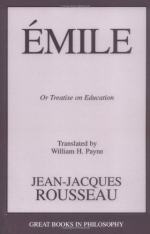I remember how I once tried to give a child a taste for chemistry. After showing him several metallic precipitates, I explained how ink was made. I told him how its blackness was merely the result of fine particles of iron separated from the vitriol and precipitated by an alkaline solution. In the midst of my learned explanation the little rascal pulled me up short with the question I myself had taught him. I was greatly puzzled. After a few moments’ thought I decided what to do. I sent for some wine from the cellar of our landlord, and some very cheap wine from a wine-merchant. I took a small [Footnote: Before giving any explanation to a child a little bit of apparatus serves to fix his attention.] flask of an alkaline solution, and placing two glasses before me filled with the two sorts of wine, I said.
Food and drink are adulterated to make them seem better than they really are. These adulterations deceive both the eye and the palate, but they are unwholesome and make the adulterated article even worse than before in spite of its fine appearance.
All sorts of drinks are adulterated, and wine more than others; for the fraud is more difficult to detect, and more profitable to the fraudulent person.
Sour wine is adulterated with litharge; litharge is a preparation of lead. Lead in combination with acids forms a sweet salt which corrects the harsh taste of the sour wine, but it is poisonous. So before we drink wine of doubtful quality we should be able to tell if there is lead in it. This is how I should do it.
Wine contains not merely an inflammable spirit as you have seen from the brandy made from it; it also contains an acid as you know from the vinegar made from it.
This acid has an affinity for metals, it combines with them and forms salts, such as iron-rust, which is only iron dissolved by the acid in air or water, or such as verdegris, which is only copper dissolved in vinegar.
But this acid has a still greater affinity for alkalis than for metals, so that when we add alkalis to the above-mentioned salts, the acid sets free the metal with which it had combined, and combines with the alkali.
Then the metal, set free by the acid which held it in solution, is precipitated and the liquid becomes opaque.
If then there is litharge in either of these glasses of wine, the acid holds the litharge in solution. When I pour into it an alkaline solution, the acid will be forced to set the lead free in order to combine with the alkali. The lead, no longer held in solution, will reappear, the liquor will become thick, and after a time the lead will be deposited at the bottom of the glass.




